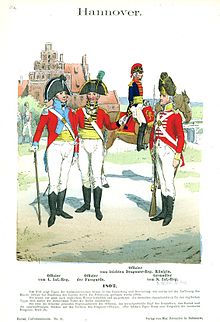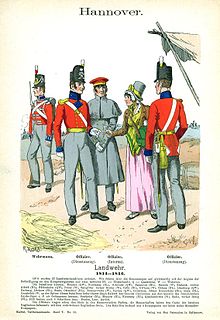Ludwig Heinrich Philipp von Ramdohr
Ludwig Heinrich Philipp von Ramdohr (* 1762 in Hoya ; † May 11, 1831 in Bleckede ) was a landowner , Westphalian canton mayor and later commander of the Hanoverian Landwehr battalion Lüneburg in the battle of Quatre-Bras .
origin
Ludwig Heinrich Philipp von Ramdohr was the second eldest son of the Land and Treasury Councilor Alexander Andreas von Ramdohr (1724–1782) and Johanna von Borries . His older brother was Basilius von Ramdohr , a younger brother was Wilken Albrecht Christian von Ramdohr (born November 11, 1766 in Drübber ; † 1823 Horneburg), later landlord at Neuhof near Lübeck and father of General Wilhelm Albrecht Andreas von Ramdohr .
Life and career
Service in the Hanoverian Army
Ludwig Heinrich Philipp von Ramdohr became an ensign in Fusilier Regiment 13A in Ratzeburg on January 20, 1780 . On July 5, 1785 he was promoted to lieutenant. In 1794 he testified in Lüchow about the arrest of an anti-feudalist preacher, which at least led to the establishment of a commission on the alleged abuses of the nobility.
In 1798 he married Christine Charlotte Luise Sophie von Schulte from the Burgsittensen family (born March 3, 1770 in Ratzeburg, † April 19, 1857 in Celle ), who was born in 1794 by her first husband, Johann Dethloff Friedrich von Oertzen (1769–1821) , was divorced. She was the daughter of Sophie Margarethe Henriette von Bülow .
On May 3, 1800 he received the title of captain in his old regiment No. 13, which in May 1801 was stationed at Lüchow, Bleckede and Bevensen, among others, and which was numbered 11 from 1802 . Until the dissolution of the Electoral Hanoverian Army according to the Artlenburg Convention in 1803, Ramdohr remained in the same rank in this regiment, whose quarters were near Ratzeburg.
Landowner and mayor in the Kingdom of Westphalia
Decommissioned in 1804 after the purchase of the estate, formerly managed by relatives of his wife, the Oertzen and Bülow families, as a fief, he became the lord of Beidendorf in the diocese of Ratzeburg (Mecklenburg) until the estate was resold to the chamberlain Hans Jasper von Both in 1810 . Ramdohr ran agriculture and published some related articles. Soon afterwards, in 1812, he acted as the royal Westphalian canton mayor in the Elbe department with the administration of the cantons Gartow and Quickborn, which were reorganized in 1811, in what is now the Lüchow-Dannenberg district, and his official residence was in Gartow, presumably until the collapse of the Napoleonic Kingdom of Westphalia.
Lieutenant Colonel of the Lüneburg Landwehr Battalion near Quatre-Bras
In the course of the autumn campaign of 1813 against France, Ramdohr was instructed to organize the newly established Landwehr battalion Lüneburg, whose headquarters were in Lüneburg, and its four companies in Lüneburg, Bevensen, Dahlenburg , Dannenberg (later in 1817 in Lüneburg, Winsen) , Bardowieck and Bleckede). He was promoted to major on January 6, 1814, and was in command of the unit that began occupying Bruges in September 1814 and occupied the Ypres fortress in March 1815 . On March 28, 1815, Ramdohr was promoted to lieutenant colonel.
In the British-Hanoverian army, according to some sources, on June 15, 1815 in Brussels he was possibly temporarily assigned to the 3rd Division under Lieutenant General Baron Carl von Alten , 1st Hanoverian Brigade under Major General Kielmannsegg , and was supposed to be in command of the Lauenburg field battalion . In the battle of Quatre-Bras , however, he commanded the 624-man Landwehr battalion Lüneburg, which belonged to the 4th Hanoverian Brigade ( Colonel Best ), and which fended off several attacks by French cuirassiers from a ditch:
"... When the enemy cavalry arrived, the commander Lieutenant Colonel v. Ramdohr ordered the Lüneburg battalion to step into the trench about 3 feet deep in order to cut off the Choc in a line; this is done with the utmost calm, while the cavalry has already come close to 200 paces; some of the officers remained standing on the road behind the battalion in order to be able to overlook the men who were coming into action for the first time. The commander of the battalion forbids all shooting, with the greatest calm and cold-bloodedness lets the enemy come within 30 paces, then commands fire and now with such a decisive effect that the entire first line of horsemen turns around and is destroyed; a second rides up; the cannon fire has meanwhile become so deafening that the companies can no longer hear the Commando des Commander; at the right moment the company bosses step in and release the fire with a similar effect ... "
On July 7, 1815, the Landwehr battalion arrived at the Neuilly camp near Paris. As part of the occupation army, Ramdohr, according to other sources, was to receive command of the Lüneburg field infantry battalion in Condé, which was planned until 1818. However, on October 30th he moved on to l'Etang with the Landwehr battalion and on December 8th, 1815, he marched back to Hanover with the 4th Hanoverian Brigade. This brigade was now under the command of Ramdohr after Colonel Best had been assigned to the Occupation Corps. On December 29, 1815, when he was awarded the Guelph Order for the first time, he received the Commander's Cross, 2nd class, as a special award. The 4th Brigade under his command, about 2,600 men, comprising the Landwehr battalions Lüneburg, Verden, Osterode and Minden, was disbanded as a troop body on January 16, 1816 before the Rhine was crossed.
On February 6, 1816, the Landwehr battalion made its ceremonial entry into Lüneburg, for which Anton Christian Wedekind wrote a text of praise to Ramdohr. The troops were then placed on peacetime strength and on February 10th they switched to normal military service. On March 8, 1816 Ramdohr was transferred to the Osnabrück light field battalion, which, as a light battalion in 1818, formed the first battalion of the royal Hanoverian 9th Infantry Regiment Osnabrück "Duke of York". In the second battalion (Landwehr battalion Osnabrück), Ramdohr's nephew Wilhelm also served as an ensign from September 4, 1815 . 1820 joined Ludwig Heinrich Philipp von Ramdohr with the character of chief of the Hanoverian army in pension . On June 6, 1825, Georg IV enfeoffed him with numerous goods, including a “ tithe at the Drübber estate of the von Ramdohr family.” Ludwig Heinrich Philipp von Ramdohr died in Bleckede in 1831 as a customs inspector on the Elbe .
Orders and decorations
- Commander's Cross 2nd class of the Guelph Order
- Waterloo medal
Works
- Ramdohr, v. (Captain): Something about the value of the working ox for Mecklenburg. Annalen des Ackerbau, 5th year 1809, 10th volume, pp. 359–389.
- Ramdohr, HP from: From the swelling of the horned cattle, and the means to be used against it. Hanoverian magazine. January 1780 (written in Niedeck ), Volume 18, Issue 7, pp. 109–110.
- Ramdohr, HP from: Something from fodder herbs. Hanoverian magazine. May 1780 (written in Niedeck), Volume 18, Issue 40, pp. 633–638.
literature
- Almanach royal de Westphalie pour l'an 1812. p. 184. Kassel 1812.
- Anton Christian Wedekind : To Lieutenant Colonel Ludwig Heinrich Philipp von Ramdohr, Commander of the Royal Guelph Order, at the entry of the battalion in Lüneburg on February 6, 1816. Stern, 1816, 4 pages.
- L. Sichart: History of the Royal Hanoverian Army. Volume 5, p. 98, Hahnsche Buchhandlung, Hanover 1870.
- Bernhard Hülsemann: History of the Royal Hanoverian Fourth Infantry Regiment and its parent bodies, from the first establishment of the latter to the year 1848, with special consideration of the campaigns of 1813, 1814, 1815 and the Schleswig-Holstein campaign of 1848. p. 99 ff, p. 105 ff. Helwing'sche Hofbuchhandlung, 1863.
- Johann von Horn: The Guelph order of the Kingdom of Hanover according to its constitution and history. P. 405. Leipzig, 1823.
- Stephan Freiherr von Welck: Franzosenzeit im Hannoversche Wendland (1803-1813): a micro-historical study of everyday life in the countryside between occupation burdens and social reforms. Edition 17 of series of publications of the local history working group Lüchow-Dannenberg. Hahnsche Buchhandlung, 2008, ISBN 978-3-7752-6127-2 .
- Friedrich Schlie : Art and historical monuments of Mecklenburg. Volume II, p. 296. Schwerin 1898.
- Bernhard Hülsemann: History of the Royal Hanoverian Fourth Infantry Regiment and its parent bodies, from the first establishment of the latter to the year 1848, with special consideration of the campaigns of 1813, 1814, 1815 and the Schleswig-Holstein campaign of 1848. Helwing'sche Hofbuchhandlung, 1863, p. 99. Limited preview in Google book search
Web links
- Private website in English. Description of the battle at Quatre-Bras based on reports from General Carl von Alten and Colonel Carl Best
- Private website in English on Quatre-Bras
Individual evidence
- ↑ From a travel diary of Herr von Anton from 1794 In: Neues Lausitzisches Magazin. Volumes 18-19, p. 342, p. 375 ff., Görlitz 1840 ( books.google.de ).
- ^ Photo of the Beidendorf manor , accessed February 21, 2015.
- ↑ Tiedemann, JG (1864): The nobility of Mecklenburg since the constitutional hereditary comparisons (1775) , page 209
- ^ Friedrich Schlie: The art and history monuments of the Grand Duchy of Mecklenburg-Schwerin. Volume: The district court districts of Wismar, Grevesmühlen, Rehna, Gadebusch and Schwerin. P. 296. Schwerin 1898 ( books.google.de ).
- ↑ Ramdohr, v. (Captain): Something about the value of the working ox for Mecklenburg , Annalen des Ackerbau, 5th year 1809, 10th volume, pp. 359–389
- ↑ Welck, pp. 175, 206
- ^ Carl von Plotho: The war in Germany and France in the years 1813 and 1814. Volume 4, p. 28 ( books.google.de ).
- ^ Karl von Damitz: History of the campaign of 1815 in the Netherlands and France…. Volume 2, p. 411. Berlin, 1838 ( books.google.de ).
- Jump up ↑ Bomann-Museum document collection, inventory L 11, No. 154
| personal data | |
|---|---|
| SURNAME | Ramdohr, Ludwig Heinrich Philipp von |
| ALTERNATIVE NAMES | Ramdohr, Philipp von |
| BRIEF DESCRIPTION | Royal Hanoverian Colonel |
| DATE OF BIRTH | 1762 |
| PLACE OF BIRTH | Hoya |
| DATE OF DEATH | May 11, 1831 |
| Place of death | Bleckede |


